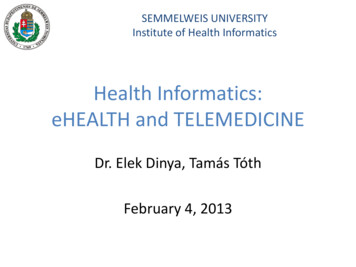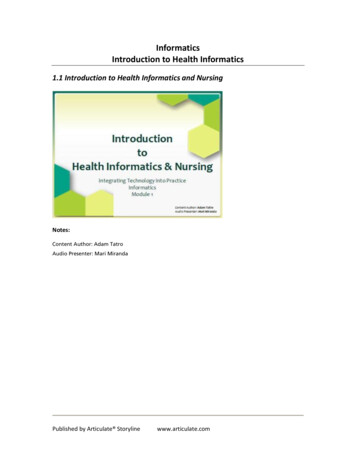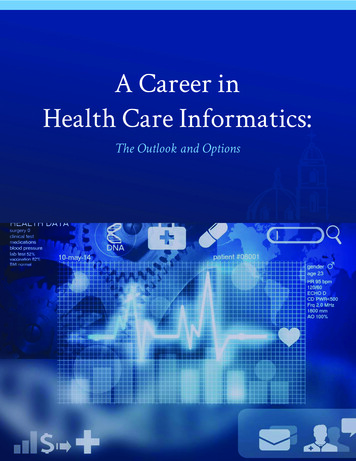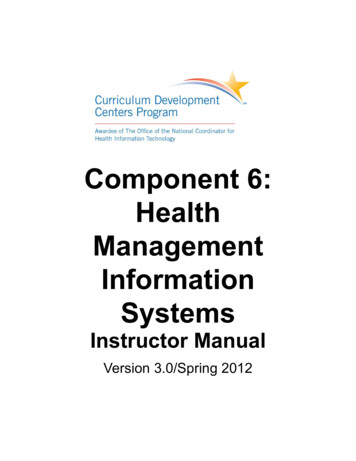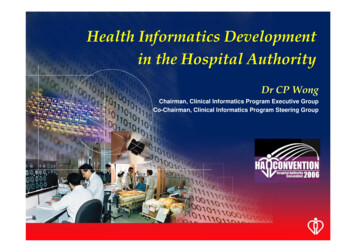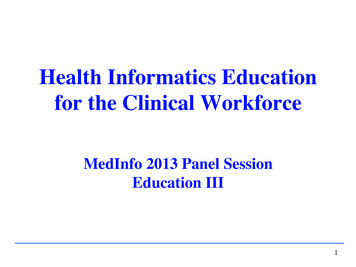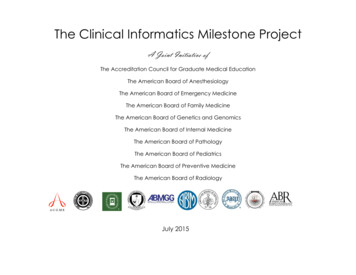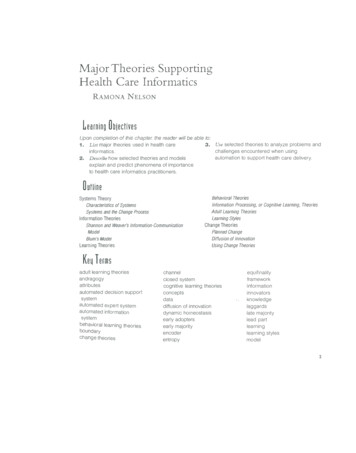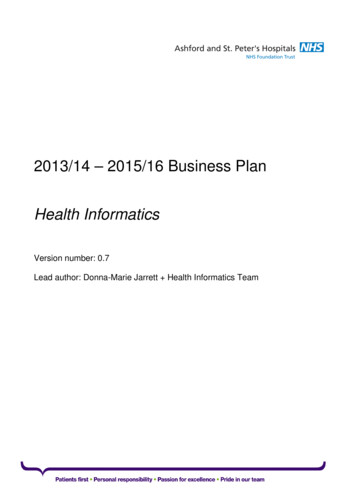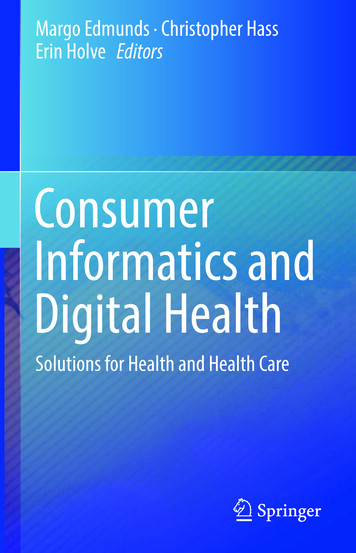
Transcription
Margo Edmunds · Christopher HassErin Holve EditorsConsumerInformatics andDigital HealthSolutions for Health and Health Care
Consumer Informatics and Digital Healthmargo.edmunds@academyhealth.org
Margo Edmunds Christopher HassErin HolveEditorsConsumer Informaticsand Digital HealthSolutions for Health and Health Caremargo.edmunds@academyhealth.org
EditorsMargo EdmundsWashington, DC, USAChristopher HassBoston, MA, USAErin HolveTakoma Park, MD, USAISBN 978-3-319-96904-6 ISBN -96906-0(eBook)Library of Congress Control Number: 2018957137 Springer Nature Switzerland AG 2019Chapter 11 is published with kind permission of Elsevier Inc. 2017This work is subject to copyright. All rights are reserved by the Publisher, whether the whole or part ofthe material is concerned, specifically the rights of translation, reprinting, reuse of illustrations, recitation,broadcasting, reproduction on microfilms or in any other physical way, and transmission or informationstorage and retrieval, electronic adaptation, computer software, or by similar or dissimilar methodologynow known or hereafter developed.The use of general descriptive names, registered names, trademarks, service marks, etc. in this publicationdoes not imply, even in the absence of a specific statement, that such names are exempt from the relevantprotective laws and regulations and therefore free for general use.The publisher, the authors, and the editors are safe to assume that the advice and information in this bookare believed to be true and accurate at the date of publication. Neither the publisher nor the authors or theeditors give a warranty, express or implied, with respect to the material contained herein or for any errorsor omissions that may have been made. The publisher remains neutral with regard to jurisdictional claimsin published maps and institutional affiliations.This Springer imprint is published by the registered company Springer Nature Switzerland AGThe registered company address is: Gewerbestrasse 11, 6330 Cham, Switzerlandmargo.edmunds@academyhealth.org
Chapter 1Promoting Consumer Engagementin Health and Health CareMargo Edmunds Introduction: Converging Influences and Larger TrendsUntil relatively recently, consumer health information was provided primarily byhighly trained professionals who were associated with privilege and personal wisdom and experience. Gradually, there has been increasing interest in relying more onthe best available evidence, professional standards of care, and personally generatedinformation from patients and consumers (Emanuel & Pearson, 2012; Fried, 2016).Consumer and patient engagement in health and health care was greatly enabledwhen personal computers became available in the mid-1980s and the Internet beganto make it possible for more people to exchange information outside of their workenvironments. Health-related websites such as WebMD , healthfinder.gov, andothers began to give consumers direct access to professional medical journals aswell as information that was translated and synthesized for lay people, allowingthem to learn about their own and their family members’ medical diagnoses andconditions (Brennan & Safran, 2005; Lober & Flowers, 2011). Consumers alsostarted some of the earliest web sites to share their personal experiences managingtheir own chronic conditions, such as asthma and diabetes, and online communitiesgrew around these common concerns and goals.As a result of gaining direct access to medical information, many people startedasking their clinicians how to interpret contradictory findings from different studies,how to know what treatment and prevention strategies would work best for them,and how they could learn more about managing their own health conditions. Thereaction from the clinical community was decidedly mixed (see, for example,Brennan & Safran, 2005; Hoch & Ferguson, 2005), but evidence was already available from a variety of sources that meaningful patient engagement can lead tobetter health outcomes (Kaplan, Greenfield, & Ware, 1989; Lorig, 2014).M. Edmunds (*)AcademyHealth, Washington, DC, USA Springer Nature Switzerland AG 2019M. Edmunds et al. (eds.), Consumer Informatics and Digital Health,https://doi.org/10.1007/978-3-319-96906-0 1margo.edmunds@academyhealth.org3
4M. EdmundsThe question was, and still is, how to move beyond just adhering to prescriptionschedules and basic recommendations about nutrition and physical activity intoeffectively engaging and supporting patients and consumers in managing theirhealth and illness across the continuum of care. We believe this happens most naturally and effectively when clinicians are meaningfully engaged in shared decision- making with patients, families, and caregivers (Elwyn et al., 2012), and whenmutual engagement is supported by electronic tools such as personal health records,portals, decision aids, and communications technologies, such as smartphones andvideoconferencing.This chapter opens with highlights of health policy discussions on consumerengagement; traces the co-development of consumer informatics and consumertechnologies, including digital health tools; describes the importance of reachingconsumers with health messages in their communities; and concludes with a discussion of emerging trends and future opportunities to transform health care throughconsumer engagement and digital health. Health Information Technology Policy and Quality of CareThe Institute of Medicine memorialized evidence about the importance of consumerengagement in its landmark 2001 report Crossing the Quality Chasm (IOM, 2001),which was part of a 10-year commitment to guide improvements in the quality ofhealth care and address growing public concern about medical errors and patientsafety. Recognizing the role of information and communications technology inredesigning health care, the IOM report recommended that system redesign shouldinclude continuous provider–patient relationships with 24/7 and virtual access;shared decision-making, with decision support tools (materials that can be consulted for more information); “unfettered access” to personal health informationand clinical knowledge; proactive anticipation of patient needs; and coordination ofcare among cooperating clinicians (IOM, 2001; See Table 1.1).Partially because health IT systems were not well developed at the time, theIOM’s twenty-first century design rules were overshadowed by the blockbuster recommendation elsewhere in the same report that health care should be “safe, effective, patient-centered, timely, efficient, and equitable” (Tang & Lansky, 2005). Thatrecommendation unleashed a storm of protest from organized medicine and hospitalgroups, but it also started a national discussion about more active engagement ofpatient and consumer groups that led to the inclusion of consumers in federal advisory bodies such as the American Health Information Community (AHIC), chartered in 2006, and many other groups.Another, largely separate, national conversation initiated at about the same timeby a different IOM report was about acknowledging racial and ethnic disparities inhealth due to systemic differences in access to care, quality of care, and social andmargo.edmunds@academyhealth.org
1Promoting Consumer Engagement in Health and Health Care5Table 1.1 These 10 design principles were recommended by the Institute of Medicine in 2001Ten rules for redesigning the healthcare system1. Care is based on continuous healing relationships2. Care is customized according to patient needs and values3. The patient is the source of control4. Knowledge is shared and information flows freely5. Decision-making is evidence-based6. Safety is a system property7. Transparency is necessary8. Needs are anticipated9. Waste is continuously decreased10. Cooperation among clinicians is a priorityAccording to the IOM report, “information technology, including the Internet, holds enormouspotential for transforming the health care delivery system, which today remains relativelyuntouched by the revolution that was swept nearly every other aspect of society” (Source: Instituteof Medicine/National Academy of Medicine Crossing the Quality Chasm report, NationalAcademies Press, 2001. Executive Summary, Recommendation 4).environmental determinants of health (IOM, 2002a). The congressionally requesteddisparities report, entitled “Unequal Treatment,” provided extensive documentationof inequities in quality of care, noting that people of color not only had the expectedfears and stress about medical treatment for illness and disease but also had to thinkabout “whether their race or ethnicity will affect the kind of care they receive”(IOM, 2002b).The bodies of evidence about patient activation and engagement and disparitieshave continued to grow, beginning with support from the Agency for HealthcareResearch and Quality and the National Institutes of Health (NIH) (e.g., Greene,Hibbard, Sacks, & Overton, 2013; Hibbard & Greene, 2013). Funding from thePatient-Centered Outcomes Research Institute (PCORI) and the Center for Medicareand Medicaid Innovation (CMMI), both created in the Affordable Care Act (CMS.gov, 2017; Dayoub, 2014), has increased the focus on best practices in using consumer technology and telehealth to support care and eliminate health disparities thatarise from social determinants of health, such as income, food security, and differential exposure to environmental risks. Significant investments from the RobertWood Johnson Foundation, The W. K. Kellogg Foundation, The Kresge Foundation,The California Healthcare Foundation, and other philanthropies have also added tothe evidence base about consumer empowerment and social and environmental factors in health.margo.edmunds@academyhealth.org
6M. Edmunds The Democratization of Health CareIn some circles, patient engagement has been compared to a “blockbuster drug”because of its power to transform care, even if it “should have formed the heart ofhealth care all along” (Dentzer, 2013). Another sign of the times for consumerengagement and shared decision-making is the recent National Academy ofMedicine (NAM, formerly the IOM) discussion paper on the democratization ofhealth care (Tang et al., 2016). Democratization means that people “must have apowerful voice and role” in their own health decisions, and that “health professionals and institutions must value social equity” and treat people as individuals, notmerely as patients, in a person-centered health care ecosystem (p. 1).The upswing in consumer informatics reflects an ongoing cultural shift withinhealthcare systems and among providers from paternalism to partnerships. In situationswhere there are choices to be made about which course of treatment to pursue, shareddecision-making can help to ensure that clinical decisions are both evidence- based andaligned with patient and family preferences and values (Lee & Emanuel, 2013).Clearly, people’s engagement in their own health and health care would not bepossible without easy-to-use digital tools such as websites, consumer portals, smartphones, and sensor-based devices that promote personalized remote monitoring,improve connectivity with clinicians and health systems, and help inform patientsand families about care options. Without the Internet and years of investments inbroadband to build local communications infrastructure, online communities andsocial networks could not have had such a major impact on patient activation amongindividuals and families managing chronic and acute care episodes.Similarly, without a national investment in health information exchange and theimplementation and adoption of electronic health records (EHRs), health care providers would not be able to support virtual visits (telehealth), consumer portals,e-prescribing, online scheduling, or other tools that promote convenience, reduceburden, and even improve accuracy of reporting. One of the major challenges healthsystems face is the need to integrate consumer-generated personal data with theirproviders’ medical records (Detmer, Bloomrosen, Raymond, & Tang, 2008; Sittig& Singh, 2010).In sum, the remaining challenges for truly shared decision-making and person- centered care are partly technological, but they are also heavily influenced by organizational and professional cultures and leadership, the views of the local providercommunity, and views about designing systems for people, or person-centereddesign (Barry & Edgman-Levitan, 2012), including the acknowledgement of racial,ethnic, and cultural differences. At this writing, in our view, there are only a fewhealth systems that truly consider the patient and family experience as an integralpart of the ecosystem of care, and part of their responsibility, including the need tobe respectful and competent regarding racial and ethnic diversity. With increasingawareness, discussion, and thought leadership, we hope and expect that many morewill be moving in this direction in the coming months and years (see Fig. 1.1).margo.edmunds@academyhealth.org
1Promoting Consumer Engagement in Health and Health Care7Fig. 1.1 The Agency for Healthcare Research and Quality (AHRQ) and the Ad Council partneredon a 2011 campaign to improve communication between clinicians and patients. Source: AHRQ/Ad Council Patient Involvement Health Care Provider Campaign. The Agency for HealthcareResearch and Quality. August 2011. Used with permission The Consumer Movement and Person-Centered Care Consumer InformaticsSince about 2000, the term consumer health informatics has been used by professionals in academic medical centers and health systems to refer to the study ofpeople’s ability to access information, participate in evidence-based care, and control their health through partnerships supported by information and communications technology (Eysenbach & Jadad, 2001; Eysenbach et al., 2002; Kaplan &Brennan, 2001).Within the multidisciplinary science of informatics, consumer informatics is oneof the five basic areas of application, along with clinical informatics, clinicalresearch informatics, public health informatics, and translational informatics(AMIA, 2017, s). Additionalinformatics divisions are based on professional domains (e.g., medicine, nursing,dentistry, and pharmacy) or practice settings (e.g., health sciences, imaging).margo.edmunds@academyhealth.org
8M. EdmundsAt the time the term consumer informatics initially came into use, provider–patient relationships were beginning to be influenced by broader trends that weresweeping other industries, particularly e-commerce and the use of the ATM (automated teller machine) by the financial services industry (Sittig & Singh, 2010).Shifting consumer expectations about responsive technology and portable recordsin health care were no match for the entrenched, paper-based legacy systems thathad grown out of fee-for-service medicine and billing for every clinical encounter.It literally took an act of Congress in 2009 (HITECH) to provide financial incentivesfor hospitals and group practices to “get out of paper” and adopt electronic healthrecords, a process which is still underway and being closely watched and studied(e.g., Buntin, Burke, Hoaglin, & Blumenthal, 2011; DeSalvo & Washington, 2016;Edmunds, Peddicord, & Frisse, 2016).One challenge in this still-emerging field of consumer informatics is the sheernumber of terms associated with it. Some terms refer to the consumer side, others tothe provider side, and still others to the technology that brings them together. Inaddition to the term consumer health informatics, or consumer informatics, severalterms are used in broader related areas of industry and health policy and practice,including connected health (Partners HealthCare Connected Health, n.d.); consumer Health IT (AHRQ, 2016; HIMSS, 2014; National Research Council, 2011);digital health (Rock Health, 2015); e-Health (ASPE, 2016; Eysenbach, 2001);e-Patient (e.g., Hoch & Ferguson, 2005); i-Health (Island Health, 2017); mobilehealth (mHealth) (Atienza & Patrick, 2011); telehealth (e.g., Kvedar, Coye, &Everett, 2014); and virtual visits (Gordon, Adamson, & Kurklinsky, 2017) (seeTable 1.2).These terms are not interchangeable: each focuses on a different part of the consumer/patient experience of technology-supported communications and has its ownconstituencies and user groups. A more standardized, accepted vocabulary wouldhelp to enhance the field’s visibility and reduce the confusion that currently characterizes it (Gibbons & Hoyt, 2014).Table 1.2 Web presence varies substantially for different terms in digital healthTermDigital healthConsumer Health ITConnected healthe-Patiente-Healthi-HealthTelehealthHealth ITmHealthConsumer informaticsGoogle results on May 4, ce: Google search conducted by the author on May 4, 2017margo.edmunds@academyhealth.org
1Promoting Consumer Engagement in Health and Health Care9Despite the lack of public visibility and funding for research, consumer informatics has continued to evolve at the intersection of people and technology. In 2011,a systematic review of consumer health informatics studies found enough evidenceto recommend that future clinical practice should integrate “patient-orientedtechnology- based” supports for health information and health behavior change, andthat researchers should learn more about how different tools work for differentgroups, such as children, the elderly, and medically underserved individuals, including racial and ethnic minorities (Gibbons et al., 2011; Kesselman, Logan, Smith,Leroy, & Zeng-Treitler, 2008).It’s also clear that future informatics studies should focus on better tailoring messages, personalizing information, and embedding feedback on personal progressinto the digital tools (Gibbons & Hoyt, 2014). These approaches are both evidence- based and time-honored traditions in the behavioral sciences (e.g., Pagoto &Bennett, 2013) but are only recently moving into the information sciences and computer sciences fields, where system design still tends to be done at a “one size fitsall” approach and customization is often seen as an extra effort and expense.Fortunately, that is beginning to change, and user experience will play a much largerrole in future systems development. Telehealth and TelemedicineTelehealth and telemedicine have been defined as the electronic exchange of healthinformation between one location and another to improve patients’ health (HealthIT.gov, 2017). The traditional uses of telemedicine have been to provide access tocare for individuals living in rural areas where there are no providers, using two- way communications such as videoconferencing and consultations with specialistsat different locations (IOM, 1996).More recently, the term telehealth has come to include a variety of provider-to- provider and provider-to-patient technologies—not only for virtual clinical visits,but also to share information and provide training and administrative services at adistance. After decades of primarily providing clinical services to Medicare beneficiaries and Native Americans living in rural and frontier areas, with some safety nettelehealth studies supported by the Health Resources and Services Administration(HRSA), telehealth is now becoming one of the fastest-growing sectors in healthcare (Edmunds et al., 2017; Tuckson, Edmunds, & Hodgkins, 2017).Recent estimates from the Department of Health and Human Services indicatethat more than 60% of all health care institutions currently provide at least sometelehealth services (ASPE, 2016). Business sector projections indicate that by 2020,virtually all large employers will include telehealth services in health benefits packages (Freeman, 2016).The Department of Veterans Affairs is greatly expanding its telehealth services,which already provide medical care to veterans around the country (Phillips &Fandos, 2017). Telehealth demonstration projects involving academic medicalmargo.edmunds@academyhealth.org
10M. Edmundscenters and federally qualified health centers in urban areas are promoting accessto specialty care and reducing patient travel burden through videoconferencing(Sikka, Redha, & Kirkpatrick, 2017). There are many other examples.To meet urban and suburban consumers’ increasing expectations of 24/7 accessto clinical providers, companies like athenahealth, American Well, Avizia, Doctoron Demand, PM Pediatrics, Teladoc, and many others are developing new servicelines and partnering with existing health systems to extend the availability of 24/7services to more locations. To protect privacy and security while promoting continuity of care, for example, the UCLA health system negotiated a contract with CVSHealth and MinuteClinic to allow connectivity to their employees’ EHRs when theysought care remotely on evenings and weekends, when they could not see theirusual clinicians (UCLA Newsroom, 2012).In response to a Congressional request, the Agency for Healthcare Research andQuality (AHRQ) commissioned a technical review of the telehealth research literature (Totten et al., 2016) to help establish the strength of the evidence base for telehealth interventions. Based on hundreds of individual studies and dozens ofsystematic reviews, the review confirmed that telehealth generally improves accessto care, reduces wait times, and increases patient satisfaction due to lower travelcosts and time burden. Further, ongoing remote monitoring for patients with chronicconditions was shown to prevent unnecessary visits, to reduce unnecessary hospitalizations, and to provide additional clinical information that helps tailor treatmentsto individual needs (Totten et al., 2016). However, the strength of the evidence basevaries for different chronic conditions (e.g., diabetes, cardiovascular disease,COPD). At this writing, a follow-on AHRQ-funded technical review is focusing onthe use of telehealth for acute and chronic specialty consultations (AHRQ, 2017).Some see telehealth as a natural extension and update of health care deliveryprocesses to keep up with the larger culture and consumer technology adoption, butmany payment and credentialing restrictions are still in place that prevent expansions (Center for Connected Health Policy, 2017). Recent legislation, including theMedicaid Access and CHIP Reauthorization Act (MACRA) and the 21st CenturyCures Act, broadened coverage for telehealth for Medicare beneficiaries and initiated studies of its impact, which will be closely watched in the provider and policycommunities in the coming years. Self-Care, Patient Education, and Behavior ChangeThere was a time, not too long ago, when most health professionals were trained tobelieve that their patients were not capable of understanding complex medical information and had to be simply told what to do: lose weight, stop smoking, get moreexercise. The main problem with that approach is that it doesn’t work.Even now, health professionals still receive relatively little training about how tohelp patients change their behaviors and lifestyle (Volpp, 2017). That may be one ofthe major reasons people have been turning to other sources of information, such associal media and online social networks, and why the digital health industry willmargo.edmunds@academyhealth.org
1Promoting Consumer Engagement in Health and Health Care11continue to attract entrepreneurs and start-ups who seek to increase consumerengagement in health through the use of new technologies.Medical Self-Care, a pre-Internet print magazine, was an early pioneer in direct- to- consumer health communications. Tom Ferguson, a fourth-year-medical studentat Yale, launched the magazine in 1976 as a “Consumer Reports focusing on healthcare” (Thomas, 1978), and then became influential in professional activities in consumer informatics. In addition to promoting the idea of social equity, in which providers and the people they treated had equal standing, Ferguson helped to formulatea framework of levels of engagement that moved from online searches for familyand friends, to seeking guidance for their own conditions, to joining and makinginquiries in online groups, and to communicating directly with clinicians throughe-mail (Ferguson, 2002; Lewis, Eysenbach, Kukafka, Stavri, & Jimison, 2005).Future approaches to unifying the field might consider updating Ferguson’s framework to take into account the dramatic changes in technology access and onlineliteracy in the 15 years since he proposed it.Another pioneer in personalized health information was Tom Pickering, an internist and hypertension expert at New York Hospital. Pickering specialized in behavioral medicine approaches that involved self-monitoring and identification ofsituations that would increase blood pressure at a time when it was still not generallyaccepted that individuals could intentionally decrease blood pressure through relaxation techniques and other behavior changes (Kabat-Zinn, 2003; Pickering, 1996).After systematic studies with his team, Pickering coined the term “white coathypertension” to refer to those individuals whose blood pressure was usually normalbut was higher when they were seen in a clinic by a medical professional becausethey were “reactive” to being in the clinic (Pickering et al., 1988). These higherreadings in the clinic could result in inaccurate diagnoses and unnecessary medications being prescribed, subjecting people to side effects such as dizziness and weakness. Ambulatory blood pressure monitoring was only in early stages at that time,but Pickering advised epidemiological research to compare the risk of heart diseaseover time for confirmed hypertensives and white-coat hypertensives (Pickering,1996). Twenty years later, medical opinions are still divided on the matter.One might wonder why it has taken so long for the work of Tom Ferguson, TomPickering, and other pioneers to influence the practice of medicine to incorporatemore behavior change and health education. There are some professional organizations, such as the Institute for Healthcare Improvement, Society of BehavioralMedicine, the Society for General Internal Medicine, the Society for MedicalDecision Making, the Society of Participatory Medicine, and others that emphasizethe partnership of people with their providers in shared decision-making in improving health. Notably, the nursing profession has been writing about shared decision- making for more than 20 years (Charles, Gafni, & Whelan, 1999; Clark et al., 2009).But as Kevin Volpp put it recently, providers receive little training in “how to createan easily navigable health improvement pathway for the patient” (Volpp, 2017, p. 2).The term “patient-centered care” was introduced by the Picker Institute in 1988and was influential in the 2001 Quality Chasm report by the IOM. It was also acenterpiece of several provisions in the Affordable Care Act, reflecting the consensus about the need to improve quality through increasing patient engagement, andhas been written about extensively (see, e.g., Berwick, 2009).margo.edmunds@academyhealth.org
12M. EdmundsAs it turns out, the adoption of “person-centered care,” the practice now recommended by the NAM, is not an evolutionary step, but a revolutionary one. There aremany sources of resistance to change (Berwick, 2009), and many consumer healthgroups have adopted the phrase “nothing about me without me” to more activelydescribe their ideal relationship with clinicians and care systems (Delbanco et al.,2001). Digital Health: Tools of EmpowermentDigital health is an umbrella term used to describe the electronic information technologies and tools that deliver services to consumers and patients and help themmanage personal health and wellness. New products and services are being developed all the time and can be classified in many ways.Gibbons and Hoyt (2014) identify six basic categories of consumer health informatics tools. They are:Mobile apps or consumer health applications designed for mobile devices such assmartphones and tablet computers. An estimated 165,000 health apps are available on the Apple Store, according to The Guardian Science (2017), a situationoften described as the “wild west” because most are not based on the evidence ofeffectiveness or user input and often ignore existing technical standards.Websites that are oriented toward health information have been developed by government, industry, health systems, and non-profit groups. Thousands have beenlaunched, and some of the more successful are WebMD, mayoclinic.org, MedlinePlus, Healthfinder, and Healthwise, a not-for-profit company with a patient education suite that can be adapted for different conditions.Interactive health games can help teach about nutrition, healthy food choices, fitness, and other positive health behaviors.Sensor-based tracking systems include devices that are wearable and/or embeddedin clothing, as well as some that are implantable. They can track respiration rate,heart rate, blood pressure, breathing patterns, blood glucose, movement, andmany other signs and symptoms.Health-related social media include platforms like Facebook and Twitter, consumerand caregiver informational and support sites, business and industry rating sitessuch as Angie’s List and Yelp, YouTube videos, and many others.Virtual reality programs are mostly in the research and design stage but are showingpromise with amputees, people with depression, and PTSD (Nichol, 2017).These and other emerging digital technologies can be used for a variety of purposes, including searching for health information; exchanging health informationwith social networks and providers; tracking symptoms to self-manage chronic conditions; making appointments; requesting ref
powerful voice and role” in their own health decisions, and that “health profession-als and institutions must value social equity” and treat people as individuals, not merely as patients, in a person-centered health care ecosystem (p. 1). The upswing in consumer infor
